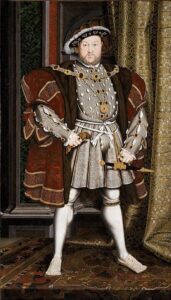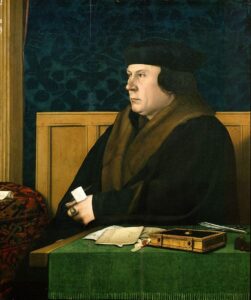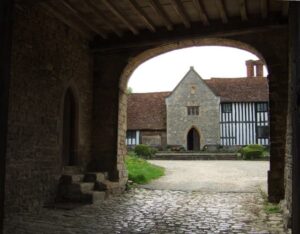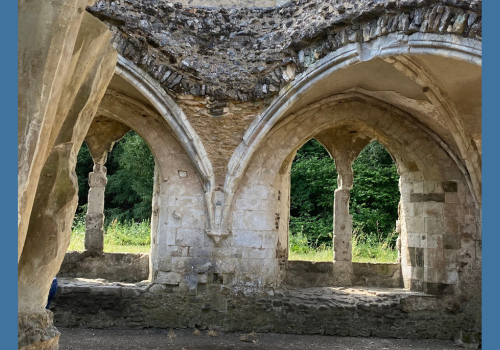•
(Caution: Contains spoilers for Episode: S04E01: Garden of Death, S07E06: The Straw Woman, and S11E07: Talking to the Dead. With a little bit of S20E01: The Ghost of Causton Abbey, S08E03: Orchid Fatalis, and S14E07: A Sacred Trust.)
Diesen Beitrag gibt es auch auf Deutsch.
•
Tom Barnaby and Ben Jones are in Bow Clayton with the Reverend Wallace Stone in his drawing room. The clergyman is standing in front of a mirror in a cassock, getting ready for the next service, while he tells the two detectives what he thinks of the legend of Monks Barton Wood: It’s about the monks of Monks Barton Abbey, slaughtered in the nearby forest by mounted men in the name of Cromwell and his Dissolution of the Monasteries. A horrific event and their screams and moans of their ghosts can still be heard in the woods, the locals say.
A legend or a true story? For the clergyman, the matter is clear and he detests the many ghost hunters and others, whom he calls fanatics and freaks. The Dissolution of the Monasteries was a cunning move by Thomas Cromwell to fill the bankrupt royal coffers richly.
A cunning move for the Royal Treasure Chests

King Henry VIII. Painted by Hans Holbein the Younger, after 1537 and during the Dissolution of the Monasteries. Public Domain.
Cromwell’s idea was by no means new, only unparalleled in its scale. During the Hundred Years’ War, Henry V had already ordered the closure of all monasteries with French mother monasteries and thus filled the state coffers in order to be able to continue financing the war against France. Even shortly before the dissolution, Cardinal Wolsey received royal permission to close 40 small monasteries in order to raise enough funds to open Christ Church College in Oxford.
Now, in the mid-1530s, King Henry VIII had declared himself head of the Anglican Church and renounced the Pope. Furthermore, he had enacted the Act of Restraint of Appeals, which allowed the Catholic clergy to appeal to foreign tribunals (means: Rome). Any resistance was treated as treason and church property confiscated. But King Henry feared war coming from Catholic continental Europe: He was completely bankrupt and on the other side were the richest in the land, namely the monasteries. Through this cunning move, Cromwell was able to ensure that the royal coffers were filled at the expense of the richest: Through a large-scale secularisation of the monasteries, which always had a reputation of partiality against the English king anyway.
In 1535 the visitations began, the results of which were compiled in the Valor Ecclesiasticus – a kind of modern Domesday Book, which contained all the goods, other possessions, but also misdemeanours of the monasteries. Very thoroughly the three royal visitators recorded the physical, moral and financial status of the monasteries and it is not surprising that among the hundreds of monasteries there were some failures: For example, the lack of chastity, obedience, charity, monastic discipline, but also money-making with false relics.
Dissolution of the Monasteries in Midsomer County

Thomas Cromwell. Painted by Hans Holbein the Younger, 1532-1533. Public Domain.
The plan of Thomas Cromwell – now appointed “viceregent of the King in all his ecclesiastical jurisdiction” – was not initially to close all monasteries, but only those with an annual income of 200 pounds or less (roughly equivalent to the purchasing power of about 170,000 pounds or about 148,000 euros (reference value: 2019 ). The Suppression of Religious Houses Act affected a total of 376 monasteries.
Lewes Priory became a precedent in 1537: the monks were offered pensions but not the option to move to another monastery. This increased the pressure on the monastic superior to agree to the dissolution.
Henceforth, the clergy of dissolved monasteries were only offered a pension, while former employees and alms recipients did not receive anything at all. But even the royal pension was far too little to survive on and caused unemployment, which was already high at the time, to rise to a striking level. This fuelled the people’s anger against the regime. Revolts broke out in several places in the kingdom, some of which Cromwell was only able to quell with great difficulty.
King Henry VIII was furious with the revolts and eventually had all the monasteries in the kingdom secularised. First, in 1538, all monasteries that had taken part in one of the revolts, and between 1538 and 1540, all others – some with unrelenting severity. It argues that Monks Barton Priory was forcibly dissolved in these last years of the decade. Perhaps the heinous harshness also stemmed from the fact that the monks had joined a rebellion?
In 1540, only the abbey churches of the cathedrals remained. Any further monastic property now belonged to King Henry VIII, who gifted his favourites with the former monastic property or kept it for himself.
Inkpen’s Manor – a royal gift?

Inkpen’s Manor also known as Long Crendon Manor, Buckinghamshire. – Rob Farrow: The Manor, Long Crendon. CC-BY SA 2.0.
Well, it is not explicitly stated in the Garden of Death episode that the Inkpen family in Midsomer Deverell got their estate as such a gift – they also could have been granted the manor otherwise as Henry VIII’s favourites. But it is relatively likely that it was through secularised church property and certain that they were favourites of Henry VIII.
On Open Day 2000, Joyce and Tom Barnaby visit the garden of Inkpen’s Manor, with its famous and much-loved Memorial Garden. The manor and the Memorial Garden are so popular that they cause traffic chaos on the local road, and the Barnabys are caught up in it. While Joyce is already looking around and reading the brochure, Tom is still grumbling about the parking situation. (But this is the only reference to the dissolution of the monasteries. Instead, the episode focuses on the much more recent Memorial Garden.)
In the chapel of love
There is also a brief mention of the Dissolution of the Monasteries in Midsomer Parva: here the chapel of Parva Manor probably previously belonged to an abbey and then came to the Clifford family through dissolution. Unfortunately, however, there are no longer any records of this transaction in the 16th century, and this provides fuel for debate.
(More Midsomer Parva history? —> This way, please.)
On one side are the Reverend Jim Hale and Alex Deakin, the curator of the church parish. On the other side is the non-religious nightclub owner and pornographer, Alan Clifford.
Tom Barnaby and Dan Scott are going to interview him after the death of Alex Deakin, curate of the local parish. The murdered man had visited Alan Clifford only the day before and it was not a friendly conversation. The two detectives are interested in what the argument was about: The church’s ownership of Clifford’s estate, of course. Alan Clifford wants to make it a chapel of love. The clergy are disgusted and insist that the church belongs to them. Clifford cannot prove that the estate was given to him during the Dissolution of the Monasteries because the records have not survived.
But now Alex Deakin has been murdered. Agnes Waterhouse replies to Tom Barnaby with a certain snappiness in her voice that the manor was dissolved at the time of Henry VIII and therefore before the first church records were created. Unfortunately, it is not clarified whether this is true.
The consequences of the Dissolution of the Monasteries
By 1540, most of the former monasteries had been sold or burnt, about 12,000 people were without work and alms and a good 8,000 religious were without a home or a task. About 100 former monastery churches became parish churches or cathedrals. In a few areas where there was no great need for building material, they fell into disrepair over the centuries and are now a tourist attraction as ruins.
Cromwell’s plan worked: The dissolution brought £1.5 million into the state coffers during Henry VIII’s lifetime. But his family also came into great prosperity. And among other things, he gave his nephew Richard seven abbeys with an income of 2,500 pounds. This was the origin of the fortune of Thomas Cromwell’s great-grandson Oliver, who a good hundred years later was one of the leading forces in the Civil War and eventually appointed himself Lord Protector. A phase of English history that also left a great many traces in Midsomer.
The filming locations: Two manors…
In Midsomer, Waverley Abbey was used as a filming location for St Frideswide’s former abbey and it is this very ruin that is used for the exterior shots of Monks Barton Abbey. But Monks Barton Priory (with the Iron Lady in the entrance, whose door Tom Barnaby slammed so carelessly), on the other hand, was filmed at Nether Winchendon House. It was also used as a location in Garden of Death, but not for Inkpen’s Manor.
Confused? Nether Winchendon House and Long Crendon Manor are only four miles apart, so they share common history. This commonality, however, does not concern the Dissolution period, but rather the Norman period. Both locations were given by King William I to Sir Walter Giffard, Lord of Longueville, new Earl of Buckingham, and William’s right-hand man, immediately after the Battle of Hastings. As such, both buildings are also listed in the Domesday Book.
Walter Giffard’s grandson of the same name endowed the Augustinian Canons’ Abbey of Notley in 1162 and a few years later gave the abbey two very nearby manors, Nether Winchendon Manor and Long Crendon Manor. They remained in their possession until the Dissolution in 1538 . All three buildings were inscribed on the National Heritage List on 25 October 1951. While Nether Winchendon House is open for visiting a few days a year, Long Crendon Manor is a B&B and the only surviving remnant of Notley Abbey – the abbot’s lodging converted to a farmhouse – is a wedding venue. From 1945 until their divorce in 1960, the farmhouse belonged to film stars Laurence Olivier and Vivien Leigh.
… and two abbeys

Waverley Abbey in June 2023, by Petra Tabarelli. Public Domain.
The Dissolution of the Monasteries in Waverley and Notley proceeded differently. While Waverley was dissolved in 1536 because its annual income of 174 pounds (1535) fell below the threshold, Notley was dissolved in December 1538. Notley’s holdings were much higher, with £318 of ecclesiastical estates and £177 of temporal estates, and her influence considerable. She was already subject to the King from 1535 anyway, after the murder of her patron, the Duke of Buckingham.
While Notley Abbey was transferred to Sir John Williams, Waverley Abbey came to Henry VIII’s treasurer Sir William FitzHerbert , was largely demolished. Later, it was used as a quarry, mainly for Loseley ParkLoseley Park. This served, among other things, as the supposed inspiration for Baroness Orczy’s Scarlet Pimpernel in They Seek Him Here, as well as Morchard Manor, where the boxing match between Hennan and Sayer took place in 1860.
As different as the dissolution of the two abbeys was, the Giffard thread runs through them. Waverley was founded in 1128 by William Giffard, son of Walter (William’s right-hand man), as the first Cistercian foundation in England.
Abbeys in Midsomer County
In addition to the two dissolved abbeys, Monks Barton and St Frideswide, there was also Causton Abbey. It is possible that this abbey was also dissolved in Cromwell’s time, but we do not have the sources for this. If this was the case, then it was only dissolved towards the end of the period, as we know from Brother Jozef’s death that the abbey still existed 1539.
There are also two abbeys in Midsomer County, namely Midsomer Abbey with Brother Robert, who can translate Latin very well, and the nuns in Midsomer Priory in Midsomer Vertue.
A little creepiness at the end
Let’s go back to the beginning of the episode in Monks Barton. Tom Barnaby and Ben Jones have just arrived at the scene of the crime at the Goodfellows’ house, which is being investigated by George Bullard. The postman found no one at the Goodfellows’, but he did find some blood and alerted the police. George tells Tom about a previous case: Peter Thomas, the son of the missing Molly and Colin. He went missing and was found a few days later in Monks Barton Wood. Completely hypothermic, he was unable to speak properly, only making eerie noises. Soon after, he died.. The official explanation for his death is hypothermia. But is it true?
At the end of the episode, Tom and Joyce Barnaby walk through the misty Monks Barton Wood in everyday clothes. Tom wants to show his wife that the wood is not haunted at all. Seconds later, Joyce is frightened at Cyrus LeVanu, who is leaning against a tree trunk. Scared to death. That’s what George Bullard later says when he has it on the table, but calls it a parasympathetic rebound. The pathologist explains: This is an automatic calming of the metabolic system in response to shock, which can work so well. However, that you calm down so much that instead of beating more slowly, your heart simply stops beating at all.
The message of the episode is clear: Peter Thomas and Cyrus LeVanu were both frightened to death in Monks Barton Woods. Caused by hypothermia? Or something else scary? Who knows…
🤓 Read more about Midsomer Murders & History
The Chronology of Midsomer County by Year or by Episodes • Deep Dives into Midsomer & History • History of Midsomer Murders Film Locations
I would like to point out that this is an unofficial fan site. I am not connected to Bentley Productions, ITV or the actors.

Literature
- Durant, Will: The Story of Civilization. Volume VI: The Reformation. A History of European Civilization from Wycliffe to Calvin. New York 1980.
- NN: Parishes. Long Crendon. In: William Page (Ed.): A History of the County of Buckingham. Volume 4. London 1927. P. 36-45.
- NN: History of Waverley Abbey. In: English Heritage.
- NN: Houses of Austin canons. The abbey of Nutley. In: William Page (Ed.): A History of the County of Buckingham. Volume 1. London 1905. P. 377-280.
- NN: Notley Abbey. An Augustian abbey and associated post-Dissolution dovecote. In: Ancient Monuments.
- Pantin, W. A.: Notley Abbey. In: Oxoniensia (1941). P. 22-48.
- Statista: Purchasing power of a British pound sterling in the years 1209 to 2019. Reference value 2019.
Further readings
- Clark, James G.: The Dissolution of the Monasteries. A New History. New Haven 2021.
- Youings, Joyce: The Dissolution of the Monasteries. London 2021.
First published on MidsomerMurdersHistory.org on 18 November 2023.
Updated on 17 May 2025.


[…] But the coup failed. Charles I then fled to Oxford and the civil war began. The real leader of the Puritans was Oliver Cromwell. A Puritan with a very strong belief in Providence and the great-nephew of Thomas Cromwell (Dissolution of the Monasteries). […]
[…] had the abbey built during his lifetime. During the Dissolution of the Monasteries it was dissolved and given to secular landowners who used the building as a residence. In 1976, […]
[…] the monasteries were dissolved, Parva Manor got the land and with it a chapel that stands near the manor, according to the […]
[…] between 1536 and 1541: During the Dissolution of the Monasteries, the Inkpens acquire a former ecclesiastical estate in Midsomer Deverell, which becomes […]
[…] settlements. While Turville’s manor long belonged to the Abbey of St Albans (until its dissolution in 1547), Bledlow was mentioned in the Domesday Book and was an intermediate station on the Wycombe […]
[…] England’s churches, especially between 1100 and 1300, but were largely whitewashed during the Reformation. They were rediscovered centuries later. This is also the case with the church crypt at Midsomer St […]
[…] since its construction in the 1560s. Stones from Waverley Abbey, which fell into ruin after the Dissolution of the Monasteries, were used in its construction – and it was itself a recurring film set for Midsomer Murders […]
[…] is the Chapel of All Saints in Brill and belonged to the Priory of St Frideswide, Oxford, until the Dissolution of the Monasteries. It was also the terminus of the Brill Tramway, which ran from Fletcher’s Cross Station, er, […]
[…] Loseley Park was built in the 16th century, partly with stones from Waverley Abbey after its Dissolution. By the time of the Domesday Book there was a building called Loosely, owned by Torald […]
[…] Abbey is a film location for: Monks Barton Abbey („Talking to the Dead“), St Frideswide („The Glitch“), Causton Abbey („The Ghost of Causton […]
[…] of Causton Abbey, 08×03: Orchid Fatalis, and 14×07: A Sacred Trust.) This article is also available in English. […]
[…] is the Chapel of All Saints in Brill and belonged to the Priory of St Frideswide, Oxford, until the Dissolution of the Monasteries. It was also the terminus of the Brill Tramway, which ran from Fletcher’s Cross Station, er, […]
[…] Cistercian foundation on English soil, was dissolved in 1536 in the course of the Reformation (Dissolution of the Monasteries). The stones of the ruins were removed and found a new home here in Loseley Park, where they have […]
[…] Between 1536 and 1541: Monks Barton Abbey is dissolved – by force, because the monks probably refused to give it up. However, they are driven into flight by the royal soldiers and literally hunted down and slaughtered in the adjacent Monks Barton Wood. (11×07: Talking to the Dead) Deep Dive: The Dissolution of the Monasteries in Midsomer Murders […]